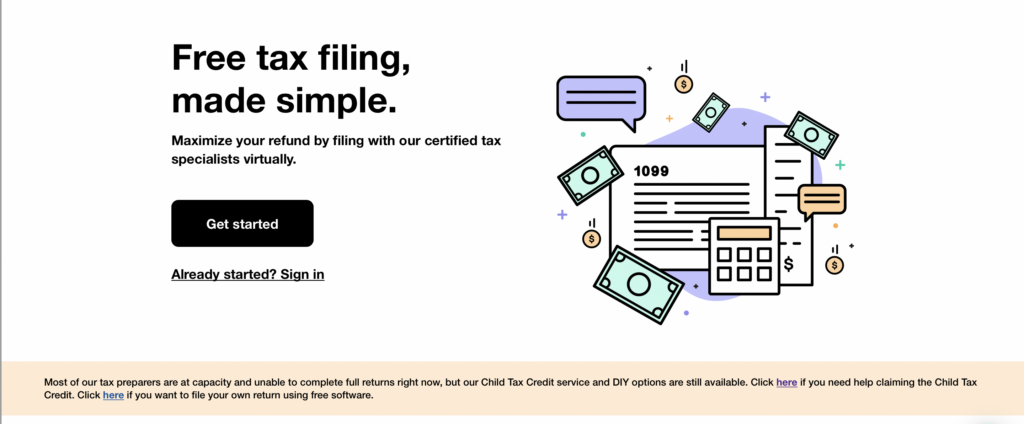

The American Rescue Plan Act, passed in March 2021, was the third federal relief package for the COVID-19 pandemic. In addition to direct aid to states and municipalities, the act included temporary changes to the tax code to provide assistance to low-income families and workers such as expansions to the Child Tax Credit (CTC) and Earned Income Tax Credit (EITC).
The expanded CTC is projected to reach just under 1.6 million children in Virginia and elevate 249,000 children above or closer to the poverty line according to the Center on Budget and Policy Priorities. However, the lowest income families may have difficulty receiving the credit if they have not filed taxes within the last two years. The Center on Budget and Policy Priorities estimates that 4 million or more children are not automatically receiving the credit.
Barriers to Filing for Non-Filers
An analysis by Code for America reveals the barriers that exist for non-filers when using the free online tax prep tool, GetYourRefund.org. This online tool was created by Code for America in partnership with the IRS’ Volunteer Income Tax Assistance (VITA) program to provide digital assistance from VITA volunteers for free and trustworthy tax prep assistance to families making less than $66,000. This analysis is based on the experiences of over 800,000 clients that used GetYourRefund.org.
Code for America found that most non-filers using GetYourRefund.org opted to use a shortened form to claim their stimulus checks, despite many being eligible for larger returns if they chose to file a full tax return for 2020. Of the 10 percent that opted to file a full return, less than 1 percent were successful in filing the full return and claiming all the benefits they were eligible for.
Despite efforts to make GetYourRefund.org widely accessible for low-income filers, there are still large barriers for non-filers. Identity verification is the largest barrier, typically because they lack access to a phone that can receive text messages or they lack a credit history. Inclusive identity verification processes are necessary to simplify the filing process.

This screenshot from GetYourRefund.org shows their warning about capacity for tax returns now.
An article by Vox also cites that the current IRS portals for the Child Tax Credit is only available in English, making it difficult for non-English speakers to navigate the portal.
Other barriers that exist for non-filers are:
Multi-pronged efforts to help non-filers must be used in order to overcome the barriers to filing. In order to increase outreach for families that may not realize they are eligible for the credit; state SNAP agencies can create targeted outreach campaigns to the lower-income families that they serve. Code for America found that outreach partnerships with SNAP agencies made families 3.5 times more likely to use GetYourRefund.org.
Community-based navigators and community organizations can help inform people of their eligibility for different tax credits and help them locate trustworthy free tax prep services. Code for America found that the use of navigators with the GetYourRefund.org system increased the rates of successful filing to 60%, as compared to 32% without assistance. Community navigators can help increase trust in these free tax prep assistance resources and can simplify the in-person VITA assistance by ensuring families have all of their documentation prior to going to file their return.
Even with additional assistance from community navigators, VITA will likely struggle to serve the increased demand as it is likely more non-filers will want to file a return than usual.
The IRS has created a non-filers tool that allows people who do not typically file input their information to become eligible for advance payments of the CTC. They will still need to file a 2021 tax return in order to claim the other half of their credit. This will likely increase the demand for free tax prep services as those who typically do not file attempt to navigate the return process to claim the credits they are entitled to.
The General Assembly convened for a special session Monday, August 2nd to determine use of funds from the American Rescue Plan Act. The current proposed Special Session budget does include funding for consulting services to determine the cost and need for translation and interpretation services. Funding for these services would be considered for inclusion in the 2022-2024 budget.
The General Assembly and state officials can provide additional resources and funding to ensure that these tax credits have the largest impact on low-income families and workers.
Additionally, Congress should make the expansions to the CTC and EITC permanent to see a lasting impact on economic stability for families and low-income workers.
Sign up to receive policy updates from Voices.
Read More Blog Posts